Chapter 5:
FACULTY and other ACADEMIC EMPLOYEES
Overview
The University of California's distinguished faculty and other academic appointees serve as a rich source of innovation, discovery, and mentorship. They provide top-quality education to students, develop groundbreaking research, and serve California's diverse communities.
Describing the academic workforce
Ladder-rank and equivalent faculty are the core of the faculty in advancing the UC's tripartite mission of teaching, research, and public service. These faculty can advance to tenure or equivalent status.[1]
In-Residence, Professor of Clinical (e.g., Medicine), Health Sciences Clinical Professor, and Adjunct Professor series faculty are found at all campus locations. However, their numbers are concentrated in the health sciences schools; their duties vary in their focus on research, clinical care, and teaching. Lecturers are focused on instruction and are hired into part-time and full-time positions. Lecturers can achieve continuing status.
Postdoctoral scholars conduct research under the general oversight of a faculty mentor. They are typically paid through research contracts and grants, so their numbers concentrate in the medical and STEM fields and vary with available grant funding.
Other academic appointees include academic researchers; cooperative extension advisors and specialists in cooperative extension; librarians; faculty administrators such as Deans; university extension instructors; graduate students appointed as Teaching Assistants and Research Assistants; and residents, interns, and other trainees in medicine and other academic health sciences programs.
Diversity
The University of California is committed to diversity and excellence in its faculty and academic workforce. The proportion of women, African American, and Hispanic/Latinx faculty continues to grow, as newer cohorts of postdoctoral degree graduates are more diverse than past cohorts. Among tenured and tenure-track faculty, UC compares favorably in terms of the proportions of women, African American, and Hispanic/Latinx faculty relative to the comparison of eight peer research institutions.[2] Still, UC continues to work to identify opportunities to diversify the faculty and improve recruitment processes and campus climate by tracking recruitment data, by sharing best practices in mentoring and professional development, and by enhancing work-life balance programs. Various programs have been put in place to strengthen faculty diversity. Two examples are Advancing Faculty Diversity and the President’s Postdoctoral Fellowship Program (PPFP).
[1] Professors of Teaching or the tenure-equivalent of associate and full agronomists and astronomers.
[2] The comparison eight institutions are University of Illinois, University of Michigan, University at Buffalo, University of Virginia, Harvard University, Massachusetts Institute of Technology, Stanford University, and Yale University.
Hiring and retention
The UC 2030 goal of adding 1,100 ladder-rank faculty between 2018 and 2030 is taking longer to achieve. Over the last six years, UC added 580 ladder-rank faculty. The hiring of new faculty has recovered from the slowdown during the COVID-19 pandemic, while separations have also seen a modest increase in recent years.
In February 2024, UC President Michael V. Drake announced the creation of the Systemwide Office of Civil Rights, alongside the issuance of a new Presidential Policy on Anti-Discrimination. This office aims to foster a safer, more welcoming environment for all members of the UC community by addressing and preventing discrimination across the system.
Effective January 1, 2025, UC broadened its paid sick leave policy to include paid sick leave accrual and usage to certain academic appointees who have a paid appointment of less than 50% FTE, to provide a paid sick leave bank to eligible faculty members, and expanded the circumstances under which sick leave can be utilized. This policy change aims to enhance work-life balance and provide greater flexibility for academic personnel
In May 2025, UC hosted the inaugural Systemwide Academic Freedom Congress, focusing on topics such as free speech on campus and university governance. This event reflects UC's dedication to upholding academic freedom and fostering open dialogue within its academic community.
As of October 2024, UC had 20,527 FTE faculty, consisting of 52.5% ladder-rank and equivalent, 35% clinical/in-residence/adjunct, and 12.5% lecturers.
5.1.1 Faculty FTE total by type

UC employees, full-time equivalent (FTE) dashboard
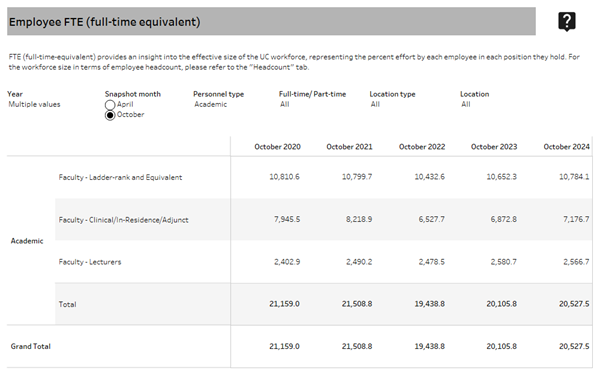
source: UC Information Center
The non-faculty academic workforce has expanded alongside student and faculty growth in the last five years, increasing by about 7 percent over this period.
5.1.2 Non-faculty academic workforce FTE

UC employees, full-time equivalent (FTE) dashboard
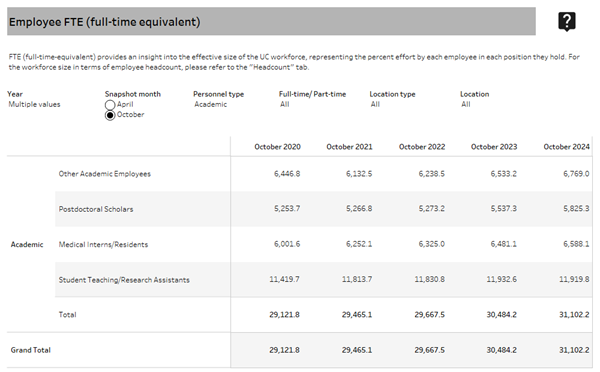
source: UC Information Center
Student teaching and research assistants hold part-time appointments in conjunction with their graduate studies. Changes in the FTE of Postdoctoral scholars and academic researchers are connected to the relative availability of research funding. Contracts and grants from external sponsors support the vast majority of researchers in the academic workforce, with the federal government providing most research funding
Postdoctoral scholars are concentrated in health sciences, biological and biomedical sciences, science, engineering, and physical sciences, as well as at campuses with larger research programs in those fields.
5.1.3 Postdoctoral scholar headcount, by campus and discipline, November 2024
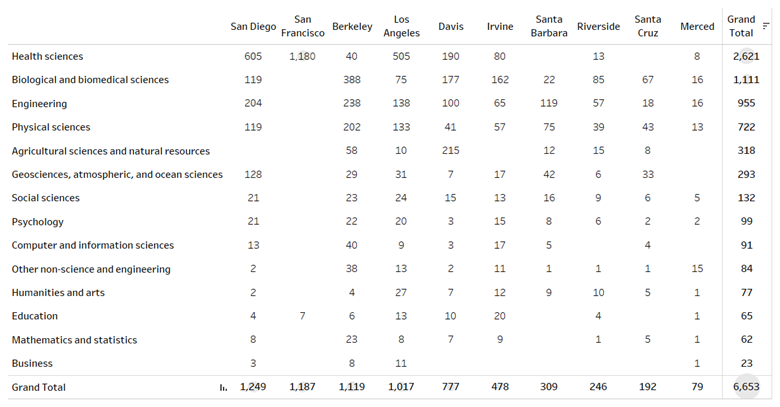
Source: UCPath
Postdoctoral scholars have completed their doctoral degrees and conduct research under the direction and supervision of faculty mentors in preparation for academic or research careers. Since most of their funding comes from contracts and grants, they are particularly prevalent in fields that receive large amounts of grant funding, such as medicine, life sciences, physical sciences, and engineering.
Campuses with large research programs in these fields consequently have larger postdoctoral populations.
The diversity of UC's academic workforce varies by employee type. Women and individuals from underrepresented racial and ethnic groups constitute a larger proportion of student teaching and research assistants, medical residents, and postdoctoral scholars than of faculty members.
5.2.1 Academic workforce race/ethnicity and gender by type

UC workforce diversity dashboard
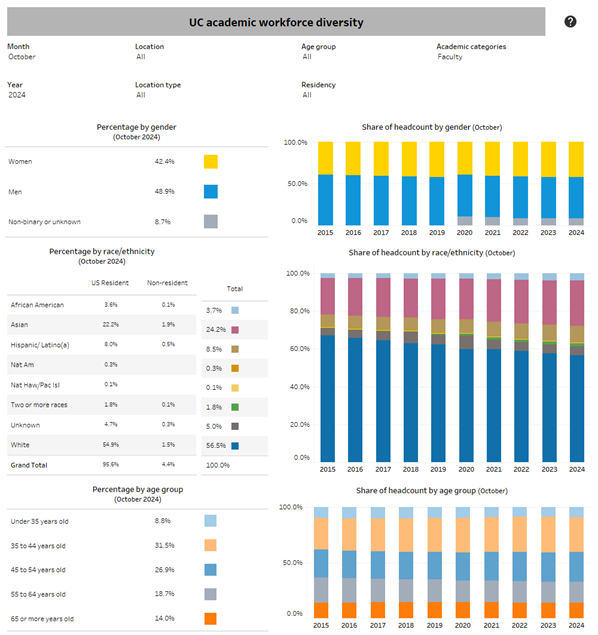
Source: UC Information Center
Positions occupied by students and recent graduates (e.g., teaching assistants, research assistants, postdocs, residents/interns) tend to be more diverse, reflecting increasing diversity in graduate student populations. Ladder-rank faculty diversity has been the slowest to change, due to long tenures and limited availability of candidates in some disciplines. The significant number of international academics reflects a global academic marketplace. UC is exploring ways to improve data quality and reverse the recent trend of growth in the share of the population with unknown race/ethnicity.
Due to the California Gender Recognition Act (SB-179), UC recently revised self-reporting options for gender identity and sexual orientation. Since that change, around 8.7 percent of faculty and 7.7 percent of non-faculty academic employees have not provided gender information.
UC has greater diversity in terms of women and Hispanic/Latinx faculty than most of its peers.
5.2.2 Percent of tenure and tenure-track faculty who are women and/or African American or Hispanic/Latinx, UC and comparison institutions, Fall 2023
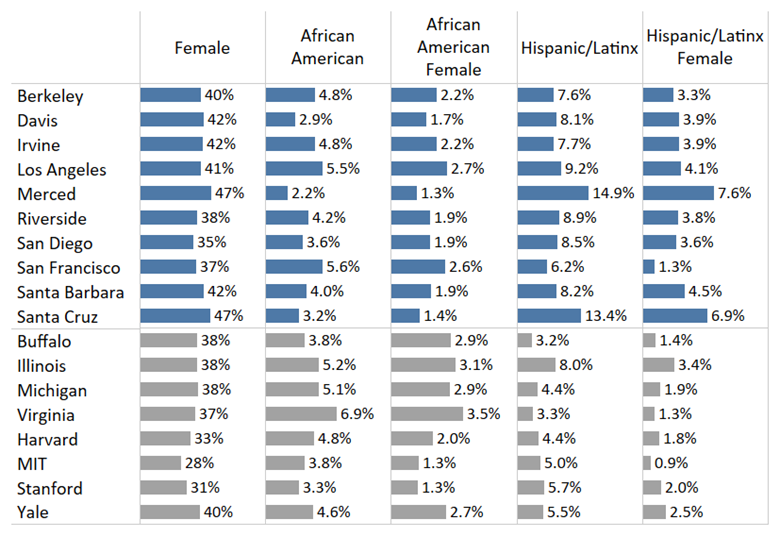
Source: IPEDS
IPEDS data does not capture race and ethnicity for employees who are not U.S. citizens or permanent residents.
Therefore, the UC data shown here may differ from other analyses of faculty demographics.
Relative to the "Comparison 8" universities (four public institutions: Illinois, Michigan, University at Buffalo, Virginia; four private institutions: Harvard, MIT, Stanford, Yale), most UC campuses have a greater share of faculty who are women. Most UC campuses have a higher proportion of African American and African American women faculty compared to private institutions, but a lower proportion compared to public institutions. Most UC campuses have a higher proportion of Hispanic/Latinx and Hispanic/Latinx women faculty compared to the comparison group. However, UC faculty do not reflect the diversity of California or UC's graduate and undergraduate students. One of the UC 2030 goals is to expand the pathway to the professoriate to help grow and diversify the faculty.
UC's hiring of African American, Hispanic/Latinx, and women faculty generally meets or exceeds the national availability of doctorates, with variation among disciplines.
5.3.1a African American new assistant professors compared with national availability by discipline group, Availabilities: 2018-2022, New hires: 2019-2023
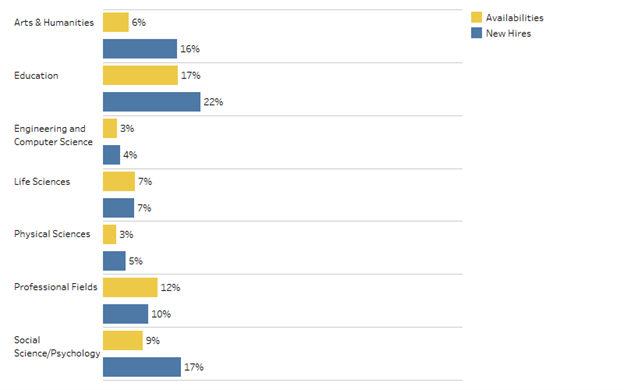
Sources: UC Systemwide Academic Personnel and Survey of Earned Doctorates
5.3.1b Hispanic/Latinx new assistant professors compared with national availability by discipline group
Availabilities: 2018-2022, New hires: 2019-2023
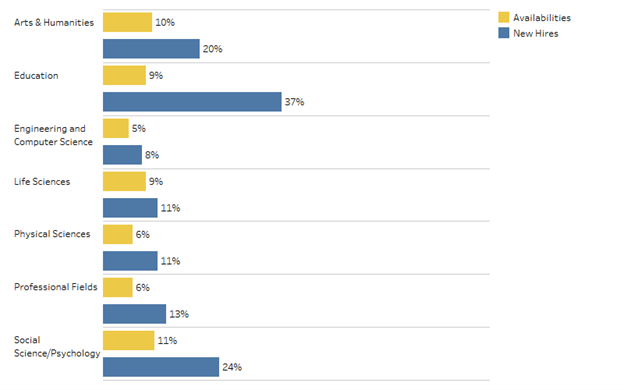
Sources: UC Systemwide Academic Personnel and Survey of Earned Doctorates
5.3.1c Women new assistant professors compared with national availability by discipline group, Availabilities: 2018-2022, New hires: 2019-2023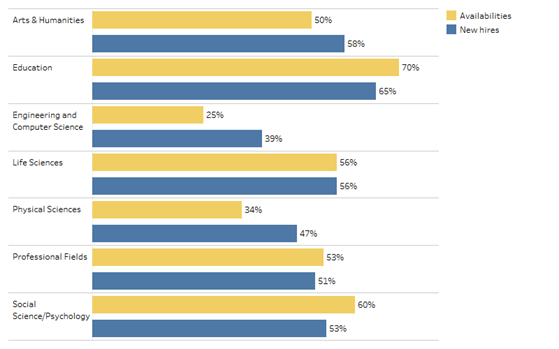
Sources: UC Systemwide Academic Personnel and Survey of Earned Doctorates
Hiring of new faculty has recovered from the slowdown during the COVID-19 pandemic. Separations are also on a modest increase in recent years.
5.3.2 New hires and separations of ladder-rank and equivalent faculty, Universitywide, 2015–16 to 2023–24

UC 2030 dashboard
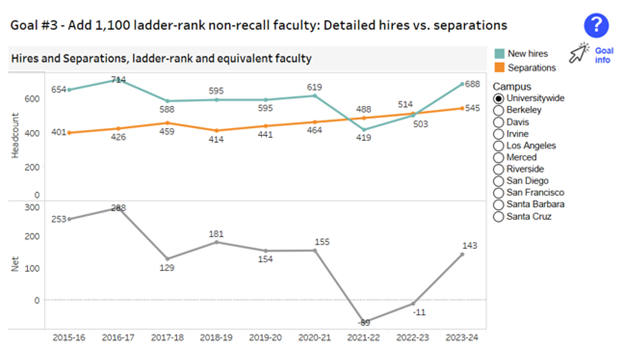
Source: UC Systemwide Academic Personnel
UC faculty salaries have increased, getting closer to market. In 2023-24, faculty salaries were three percent below market.
5.3.3 Ladder-rank faculty salaries as a percentage of market, 2013-14 to 2023-24

University of California Budget for Current Operations 2025-26 report
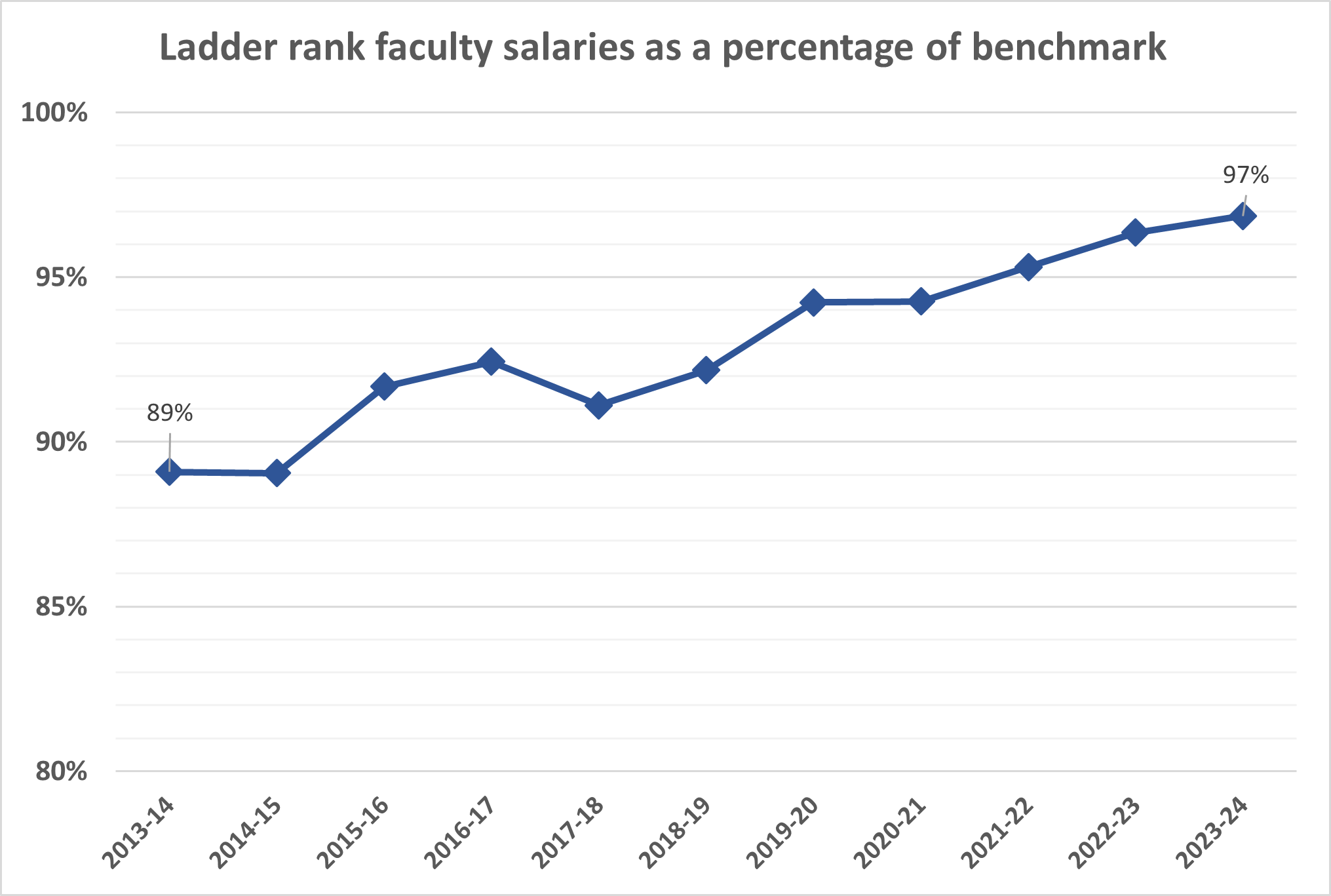
Source: UC Budget for Current Operations, 2025-26
Past cuts to the University's budget have resulted in disparities in faculty and staff salaries compared to the market benchmark. Due to funding constraints, the University has struggled to bring faculty salaries to par with comparators. As of 2023- 24, UC's faculty salaries were three percent below market.
5.3 ACADEMIC HIRING AND RETENTION
UC is 53 percent of the way to the UC 2030 goal of hiring 1,100 ladder-ranked and equivalent faculty.
5.3.4 UC ladder-rank faculty headcount, excluding recall faculty*, Universitywide, October 2018 to 2024

UC 2030 dashboard

Source: UC Corporate Personnel System and UCPath
* Recall faculty are retired faculty who return part-time for temporary instruction and/or research needs.
They are excluded here to focus on more permanent faculty appointments only.
Growth among UC ladder-rank and equivalent (LRE) faculty has been modest over the last couple of decades, relative to the growth in the student body. One of UC's goals in the multi-year framework adopted by the UC Regents in 2019 is investing in the next generation of the professoriate. To fulfill this, UC set a goal to grow non-recall LRE faculty by 1,100 between 2018 and 2030. UC added 580 net new faculty by October 2024 and is on track to meet this goal.
5.3 ACADEMIC HIRING AND RETENTION
UC new hires are more diverse than current UC faculty with opportunities to further develop various pathways to the diverse professoriate as a part of its 2030 goals.
5.3.5 UC pathways to professoriate
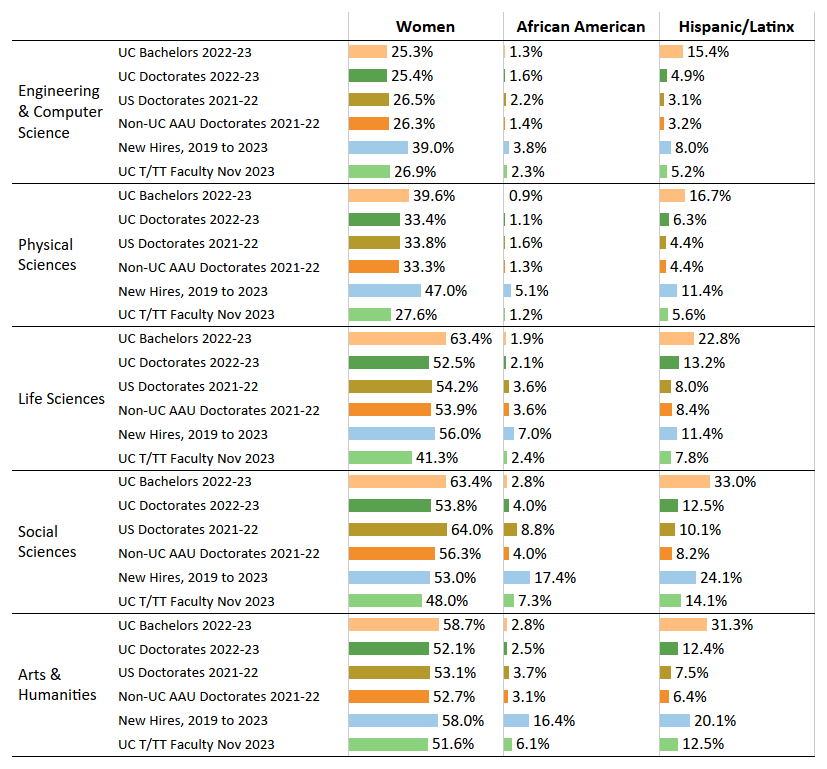
Source: UC Systemwide Academic Personnel, UCPath, IPEDS HR
Investing in the next generation of diverse professoriate is one of the three goals of the UC 2030 framework. UC continues to deploy the strategy of growing the graduate and future professoriate pathway, including additional ladder-rank faculty to increase UC's capacity to grow graduate student numbers. While UC is hiring new faculty from historically underrepresented groups, through its Grow our Own initiative, UC is also cultivating an internal talent pool by creating more research opportunities for undergraduate students and working to encourage more students from underrepresented groups in UC undergraduate programs to pursue doctoral degrees.
![]()











